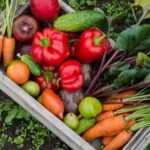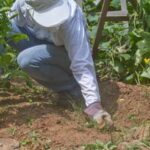Arizona desert vegetable gardening presents unique challenges due to the harsh climate and limited water supply. With the right knowledge and techniques, however, it is possible to grow a variety of vegetables in this environment. In this article, we will explore the best practices for successful desert vegetable gardening in Arizona, including choosing the right vegetables, soil preparation, watering techniques, sun protection strategies, pest and disease management, seasonal planting and crop rotation.
The key to successful Arizona desert vegetable gardening lies in selecting the right vegetables that can thrive in hot and arid conditions. Understanding the unique challenges of this environment is crucial for cultivating a bountiful garden. Additionally, proper soil preparation and management are essential for ensuring the health and growth of vegetables in the desert climate.
Watering techniques and irrigation systems play a critical role in desert vegetable gardening, especially in dry climates like Arizona. Effective sun protection and shade strategies are also necessary to protect delicate plants from intense heat. By embracing these challenges with the right knowledge and practices, gardeners can experience remarkable success in growing vegetables in the Arizona desert.
Choosing the Right Vegetables for the Arizona Desert Climate
When it comes to vegetable gardening in the Arizona desert, selecting the right vegetables is crucial for a successful harvest. The extreme temperatures and arid conditions make it challenging to grow traditional garden crops, but with careful consideration, it is possible to cultivate a bountiful garden in this unique environment.
Several vegetables have been found to thrive in the arid climate of Arizona, including tomatoes, peppers, eggplant, and cucumbers. These warm-season crops are well-suited to the high temperatures and low humidity of the desert region. Additionally, root vegetables such as radishes, carrots, and beets are also good choices for desert gardening due to their adaptability to sandy soils and minimal water requirements.
It is important to prioritize native and drought-resistant vegetable varieties when planning an Arizona desert vegetable garden. These varieties have adapted to the harsh environmental conditions and require less water, making them suitable for sustainable gardening practices in this region. By choosing vegetables that are well-suited to the desert climate, gardeners can maximize their chances of a successful harvest while conserving water resources.
In addition to selecting the right vegetables for the Arizona desert climate, it is essential to consider planting times and seasonality. Understanding when to plant certain crops based on temperature patterns and anticipated frost dates is crucial for optimizing growth and productivity in a desert vegetable garden. By carefully selecting appropriate vegetables and timing their planting according to seasonal variations, gardeners can overcome the challenges of arizona desert vegetable gardening and enjoy a thriving garden all year round.
Soil Preparation and Management for Successful Desert Vegetable Gardening
When it comes to Arizona desert vegetable gardening, soil preparation and management are crucial aspects that can determine the success of your garden. The arid climate and sandy soil in the Arizona desert present unique challenges for growing vegetables, but with the right approach, it is possible to create a thriving garden.
One of the first steps in soil preparation for desert vegetable gardening is to test the pH levels of the soil. Most vegetables thrive in slightly acidic to neutral soils, so it’s important to ensure that the pH level falls within the optimal range. Additionally, incorporating organic matter such as compost or well-rotted manure into the soil can improve its structure and fertility, providing essential nutrients for plant growth.
In terms of soil management, mulching is an effective technique for conserving moisture and regulating soil temperature in the arid environment of the Arizona desert. Organic mulches like straw or wood chips can help prevent water evaporation from the soil surface and reduce weed growth. Additionally, drip irrigation systems combined with mulching can further enhance water efficiency in desert vegetable gardening.
| Soil Preparation Techniques | Soil Management Strategies |
|---|---|
| Test pH levels | Mulching for moisture conservation |
| Incorporate organic matter | Use of drip irrigation systems |
Watering Techniques and Irrigation Systems for Dry Climates
When it comes to Arizona desert vegetable gardening, one of the most critical factors for success is implementing proper watering techniques and irrigation systems. The dry climate of the Arizona desert presents unique challenges when it comes to keeping vegetable plants properly hydrated. Without adequate water, plants are more susceptible to stress, stunted growth, and even death. Here are some essential tips for effectively watering your desert vegetable garden:
- Choose drought-tolerant vegetables: Opt for vegetables that require less water to thrive in the arid Arizona climate. Examples include tomatoes, peppers, squash, and melons.
- Implement a drip irrigation system: Drip irrigation delivers water directly to the base of plants, reducing evaporation and ensuring that water reaches the roots where it is needed most.
- Water deeply and infrequently: Instead of frequent shallow watering, which can lead to shallow root systems, water your vegetable garden deeply but less often. This encourages deeper root growth and greater plant resilience.
In addition to these tips, it’s important to consider the timing of watering. In the hot Arizona desert climate, it’s best to water early in the morning or late in the evening when evaporation rates are lower. This helps maximize the effectiveness of each watering session and ensures that plants have access to moisture when they need it most.
Lastly, mulching can also be beneficial for reducing water evaporation from the soil and maintaining consistent soil moisture levels. Whether using organic materials like straw or wood chips or inorganic options such as plastic mulch, a layer of mulch around your vegetable plants can help conserve water in your desert garden.
By incorporating these watering techniques and irrigation systems into your Arizona desert vegetable gardening practices, you can mitigate the challenges posed by the arid climate and cultivate a thriving garden full of delicious vegetables.
Sun Protection and Shade Strategies for Desert Vegetables
When it comes to growing vegetables in the arid Arizona desert, one of the biggest challenges is protecting plants from the intense sun and heat. Without adequate shade and sun protection, vegetable plants can easily suffer from sunburn, wilting, and reduced productivity. Fortunately, there are several effective strategies for providing the necessary shade and protection for desert vegetables.
Use of Shade Cloth
One popular method for providing shade to vegetable plants in the Arizona desert is the use of shade cloth. This lightweight fabric can be draped over plants to reduce the intensity of the sun’s rays while still allowing air circulation. Shade cloth comes in different levels of shading, so it’s important to choose the right percentage based on the specific needs of the vegetable crop being grown.
Strategic Plant Placement
Another way to provide natural shade for desert vegetables is by strategically placing taller plants or structures to create temporary shade during the hottest part of the day. For example, planting taller vegetable crops like corn or trellised vines on the west side of a garden can help provide some relief from afternoon sun exposure for smaller, more delicate plants.
Timing Watering and Mulching
In addition to providing physical shade, proper timing of watering and mulching can also help protect desert vegetables from excessive heat. Watering in the early morning or late evening can prevent water droplets on leaves from magnifying sunlight and causing damage. Additionally, using organic mulch such as straw or wood chips can help insulate soil and retain moisture while also providing some shading for plant roots.
By implementing these sun protection and shade strategies, Arizona desert vegetable gardeners can better equip their crops to thrive in harsh conditions and ultimately enjoy a bountiful harvest despite the challenging climate.
Pest and Disease Management in the Arizona Desert
Common Pests in the Arizona Desert
The arid climate of the Arizona desert brings with it a unique set of pests that can wreak havoc on vegetable gardens. Common pests in the area include aphids, spider mites, whiteflies, and caterpillars. These pests can quickly damage crops and reduce yields if left unchecked. It’s important for gardeners to be proactive in pest management to maintain healthy plants.
Natural Pest Control Methods
Given the harsh desert environment, chemical pesticides may not always be the best solution for pest control in Arizona desert vegetable gardening. Instead, many experienced gardeners turn to natural methods such as introducing beneficial insects like ladybugs and lacewings to combat harmful pests. Additionally, using insecticidal soaps or neem oil can effectively manage pest populations without harming beneficial insects or contaminating the soil.
Disease Prevention and Management
In addition to pests, diseases also pose a threat to vegetable crops in the Arizona desert. The dry climate can create conditions favorable for certain fungal diseases such as powdery mildew and root rot. To prevent these issues, it is essential to practice good sanitation by removing dead plant material and practicing proper spacing between plants for adequate air circulation. Applying organic fungicides or using disease-resistant plant varieties are also effective strategies for managing diseases in desert vegetable gardens.
By implementing these pest and disease management techniques, Arizona desert vegetable gardeners can protect their crops from potential threats and ensure a successful harvest despite the challenges posed by the arid climate.
Best Practices for Seasonal Planting and Crop Rotation
Arizona desert vegetable gardening comes with its own set of challenges, including extreme temperatures, low humidity, and poor soil quality. However, with the right knowledge and techniques, successful vegetable gardening in the desert is entirely possible. One important aspect of maintaining a thriving desert vegetable garden is the practice of seasonal planting and crop rotation.
Seasonal planting involves selecting the appropriate vegetables to plant at specific times of the year based on the climate and temperature patterns in the Arizona desert. For example, cool-season vegetables such as lettuce, spinach, and carrots should be planted in the fall or winter, while warm-season crops like tomatoes, peppers, and squash thrive in the spring and summer months.
Crop rotation is another crucial practice for maintaining soil fertility and preventing disease in a desert vegetable garden. By rotating crops from different plant families in designated areas of the garden each season, gardeners can minimize nutrient depletion and reduce the buildup of pests and diseases that target specific plant types.
Successful management of seasonal planting and crop rotation not only contributes to healthier plants but also increases overall yield and quality of produce in an Arizona desert vegetable garden. By following best practices for these essential techniques, gardeners can maximize their chances of a successful harvest despite the harsh conditions of the desert climate.
| Seasonal Planting | Crop Rotation |
|---|---|
| Plant cool-season vegetables in fall/winter | Rotate crops from different plant families |
| Plant warm-season crops in spring/summer | Minimize nutrient depletion |
| Maximize chances of a successful harvest | Maintain soil fertility |
Success Stories and Tips From Experienced Arizona Desert Vegetable Gardeners
Aspiring Arizona desert vegetable gardeners may find inspiration and practical tips from experienced individuals who have successfully cultivated thriving gardens in the challenging desert climate. Their success stories and valuable insights can provide invaluable guidance for those looking to embark on their own desert vegetable gardening journey.
Here are some tips and success stories from seasoned Arizona desert vegetable gardeners:
- Selecting the Right Vegetables: Experienced gardeners in the Arizona desert emphasize the importance of choosing heat-tolerant and drought-resistant vegetables that are well-suited to the arid climate. Some popular choices include tomatoes, peppers, eggplants, and squash, as these vegetables can withstand the intense heat and limited water conditions characteristic of the region.
- Soil Preparation and Management: Successful Arizona desert vegetable gardeners stress the significance of proper soil preparation and management. They recommend amending the soil with organic matter such as compost or aged manure to improve its structure, fertility, and water retention capabilities. Additionally, they advise using raised beds or container gardening to ensure adequate drainage and aeration for healthy plant growth.
- Watering Techniques: Effective irrigation is essential for successful arizona desert vegetable gardening. Experienced gardeners in the region suggest utilizing drip irrigation systems or soaker hoses to deliver water directly to the plant roots while minimizing evaporation loss. They also emphasize the importance of deep, infrequent watering to encourage deep root development and reduce moisture stress on plants.
By heeding the advice and experiences of knowledgeable Arizona desert vegetable gardeners, newcomers can gain valuable insights that will enhance their chances of achieving a productive and flourishing garden in this unique environment. Embracing tried-and-true practices while adapting them to individual circumstances can lead to a bountiful harvest of fresh, homegrown produce despite the challenges posed by arizona desert vegetable gardening.
Conclusion
In conclusion, Arizona desert vegetable gardening presents unique challenges, but with the right knowledge and techniques, it can be a rewarding and fruitful endeavor. By choosing the right vegetables for the climate, preparing and managing the soil effectively, implementing proper watering techniques and irrigation systems, providing sun protection and shade strategies, as well as practicing pest and disease management, gardeners can successfully grow a variety of vegetables in the Arizona desert.
Seasonal planting and crop rotation are also essential practices to ensure the health and productivity of a desert vegetable garden. Experienced Arizona desert vegetable gardeners have shared their success stories and valuable tips that can help newcomers navigate the challenges of gardening in this arid climate.
Despite its harsh conditions, with dedication and perseverance, it is possible to embrace the bounty of desert vegetable gardening in Arizona. The satisfaction of growing one’s own fresh produce amidst such challenging circumstances is truly fulfilling. With the right approach and commitment, anyone can enjoy a thriving vegetable garden in the Arizona desert.
Frequently Asked Questions
What Vegetables Do Well in Arizona Heat?
Vegetables that do well in Arizona heat include tomatoes, peppers, cucumbers, zucchini, and melons. These vegetables thrive in the hot and dry climate, as long as they are given adequate water and protection from intense sun.
How Do You Grow Vegetables in the Arizona Desert?
Growing vegetables in the Arizona desert requires careful planning and consideration of the extreme conditions. It’s important to choose heat-tolerant varieties, provide ample water through drip irrigation or soaker hoses, and protect plants from the scorching sun with shade cloth or by planting them near taller crops for natural shade.
What Is the Easiest Vegetable to Grow in the Desert?
The easiest vegetable to grow in the desert is likely the hardy and adaptable okra. This vegetable is known for its resilience to high temperatures and low water availability. It thrives in the desert climate and can produce an abundant harvest with minimal care.

If you’re looking to get into vegetable gardening, or are just looking for some tips on how to make your current garden better, then you’ve come to the right place! My name is Ethel and I have been gardening for years. In this blog, I’m going to share with you some of my best tips on how to create a successful vegetable garden.





